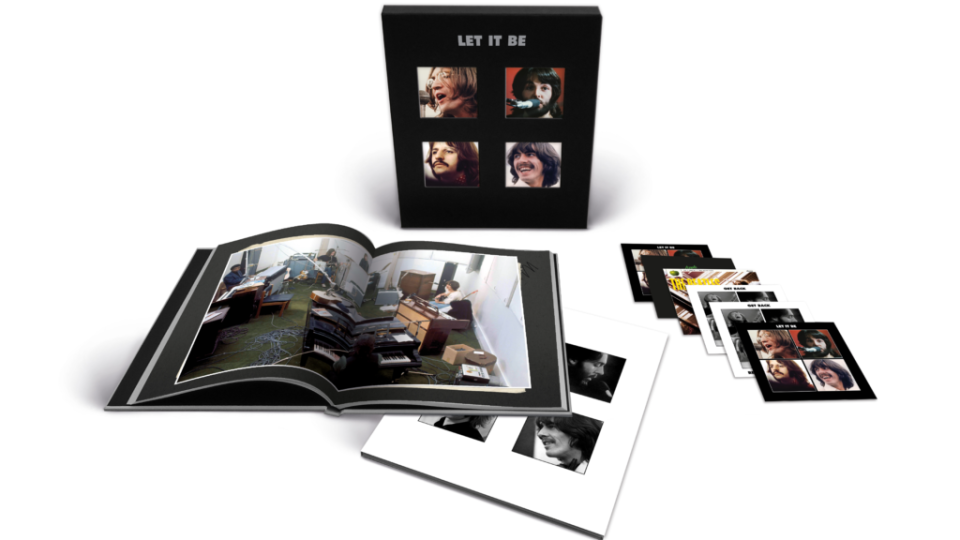Let It Be – Super Deluxe Version Repaints the Beatles’ Final Album
- Oops!Something went wrong.Please try again later.
The controversy that surrounds the album Let It Be down the years makes it the most intriguing release by The Beatles. Many observers consider it ill-conceived, a slapdash affair and a sad ending to a great legacy. It is doubtful any band (of any longevity) had as much influence as The Beatles in their seven-year recording career. McCartney still peppers his live setlist with the title track. Some call it a very weak album, but with three No. 1 singles, it certainly warrants the current attention.
The story is fairly well known. McCartney hatched the idea of capturing on film the band creating, rehearsing and performing entirely new songs. In the cavernous and dank Twickenham film studios the band gathered on the second day of 1969 (“like playing table tennis in a football stadium”). The forthcoming film from Peter Jackson will debunk the grim proceedings, but quickly the studio in the basement of the band’s offices offered a second and more productive venue. The intimacy apparently helped, as did the addition of Billy Preston (who became the only other artist ever credited on a Beatles single).
The 57 tracks in the Super Deluxe version are spread across 5 CDs and a Blu-Ray, with a lavish hardcover book, all delivered in a handsome slipcase. Purists can have it all in vinyl and modern folk can get it all in hi-res 96kHz/24-bit / Dolby Atmos digital mixes.

In the voluminous liner notes, Giles Martin offers some reassuring observations about his father’s role, indicating the latter once said the album credits should have read “Produced by George Martin, Overproduced by Phil Spector.” But the younger Martin not only points out that the role of fellow producer Glyn Johns was crucial, but that the band was “like an old married couple trying to go out on dates again.” A prime example of that was “One After 909,” a song written by the band in 1960 but unearthed and recorded admirably for these sessions. “I Me Mine” was probably the song that gave we punters a glimpse and apparent proof that not all was well among the four Liverpudlians; George Harrison laments about all the self-serving positions taken by those around him. Late in the proceedings, the recordings on the roof of the Apple Records offices were indeed the closest the band came to recapturing the excitement they experienced in their youth, and fittingly it was their last live performance.
Included is the famous Glyn Johns mix, which was a one-off idea the producer had to recreate the fly-on-the-wall nature of the proceedings. Presented like a tasteful bootleg (which it often was), the songs are supplemented with more studio chatter, and in different order. The remastered version of the original album is fuller than most folks will recall from their original hi-fi setups. Most noticeable is “For You Blue” with Paul’s piano efforts brought forward.
The most fascinating disc is the “Rehearsals and Apple Jams” collection. It opens with the lads exchanging New Year’s greetings, and segues nicely into the prophetic “All Things Must Pass.” Fortunately for George, his brethren could not do justice to the song and it thereafter became the bedrock of his epic solo release (which also recently was give the royal reissue treatment). Most poignantly, Paul and Ringo performed the song 34 years later at the Royal Albert Hall at The Concert for George, the sterling tribute gathering a year after their bandmate’s death.
On “Gimme Some Truth,” we hear Lennon trying to get the band intrigued about recording the song, but the definitive version would need to wait for just another day. The disc is fleshed out with studio chatter and intriguing early versions of songs that would appear on Abbey Road, the last album they recorded.
Across the 57 tracks, we hear the band exploring music that would become timeless. Although “Get Back” is the only song that met the original criterion of being created from scratch to finish, there is much to enjoy. We go from being a fly in the wall in cavernous Twickenham, to a spy in the basement studio and then a lucky visitor to the roof of their offices at 3 Savile Row. The latter is the distant second obligatory visit on any tour of The Beatles’ London, their last public performance.
McCartney’s foreword puts a happier spin on his feelings about the original album “I must admit, I was not keen on some of his additions it turned out to be a fine Beatles album in the end.” Actually, shortly after Lennon gave the tapes to Phil Spector, McCartney reacted to the addition of Spector’s wall of sound treatments with a legal letter. And in 2003, McCartney was able to release Let it Be – Naked, a stripped-down version of the original recordings.
The brush of memory indeed paints with golden strokes. McCartney has the final word, referring to the forthcoming six-hour docuseries and this remastered collection, “It is how I want to remember The Beatles.”
The post <i>Let It Be – Super Deluxe Version</i> Repaints the Beatles’ Final Album appeared first on SPIN.

